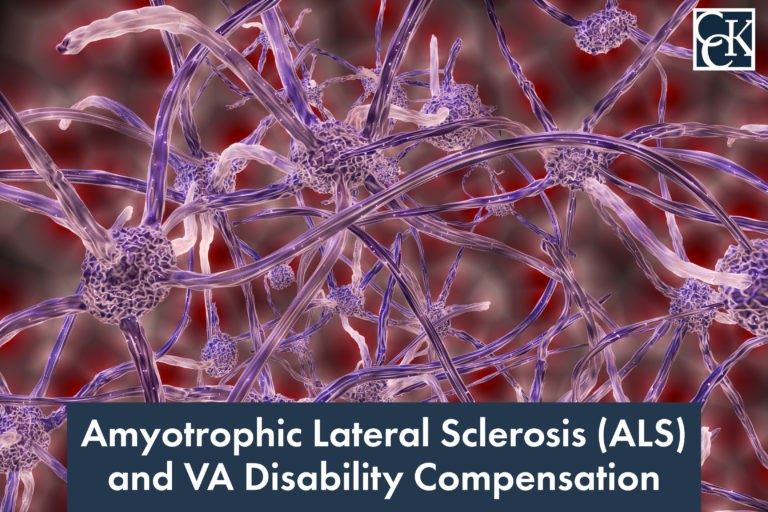Amyotrophic Lateral Sclerosis (ALS) and VA Disability Compensation

CCK Law: Our Vital Role in Veterans Law
Amyotrophic Lateral Sclerosis (ALS), also known as Lou Gehrig’s disease, is a rare, progressive neurogenic disease that affects nerve cells in the brain and spinal cord. ALS causes the neurons that control voluntary muscles to die which can result in the gradual weakening of the muscles.
The ALS Association website states that military veterans are approximately twice as likely to be diagnosed with ALS as the general public. The reasons as to why are unknown but may be related to an instance of Traumatic Brain Injury (TBI) or exposure to environmental toxins.
The VA’s ALS Presumption
For military veterans with ALS, the VA will grant presumptive service connection if the disease manifested at any time after discharge from military service. However, there are some exclusions for this presumption.
Under 38 C.F.R. 3.318, the VA states that presumptive service connection for ALS will not be established if:
- “[…] there is affirmative evidence that [ALS] was not incurred during or aggravated by active military, naval, or air service;”
- “[…] there is affirmative evidence that [ALS] is due to the veteran’s own willful misconduct; or”
- “[…] the veteran did not have active, continuous service of 90 days or more.”
For veterans who served in the reserves or National Guard without 90 days or more of active, continuous duty, the VA will not grant presumptive service connection for ALS.
What Is Presumptive Service Connection?
Presumptive service connection is a means of service connection for a condition or disease that was caused by or the result of military service. Under most circumstances, veterans will likely pursue direct service connection for their disease or injury. Direct service connection requires three elements in order to be granted:
- A medically diagnosed disease or condition;
- Evidence of an in-service event, injury, or disease;
- A medical “nexus” linking the currently diagnosed disability with the in-service event.
However, for presumptive service connection, veterans do not need the third element: the “nexus.” Instead of needing to provide evidence linking a condition to military service, the VA will assume that a veteran’s military service caused their current disability. Presumptive service connection is commonly associated with diseases caused by exposure to Agent Orange or other herbicides in service, but the VA also allows for presumptive service connection in other circumstances.

Back to the ALS Presumption
The regulation for the ALS presumption is unique among VA regulations in that it does not require a veteran’s ALS to have developed within a certain time frame following service. In the regulation, a veteran’s ALS can have developed or been diagnosed at any point following their military service, whether it be two months or twenty years after their discharge.
To qualify for the presumption, veterans will still need a formal diagnosis of ALS, and at least 90 days of active, continuous military, naval, or air service.
Veterans of the National Guard do not qualify for the ALS presumptive under VA’s regulation. Additionally, if it has been shown that a veteran’s ALS is a result of their own willful misconduct during service, such as drinking and driving or using illegal drugs, they will not qualify for service connection under the regulation.
How to Expedite an ALS VA Claim
Veterans diagnosed with ALS qualify for priority processing and may submit a request to VA asking that their claim be addressed in a more expedient manner. To submit a Priority Processing Request, the Veteran should fill out VA Form 20-10207, a five-page form that outlines the instructions for submission.
If the medical evidence showing an ALS diagnosis is not already on file with VA, veterans will want to submit the diagnosis, as well as the Priority Processing Request form. Veterans may also submit completed VA Form 21-4142 and Form 21-4142a to request that VA obtain their private treatment records, if a veteran treats outside a VA Medical Center for their Amyotrophic Lateral Sclerosis.
About the Author
Share this Post
